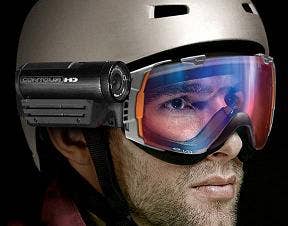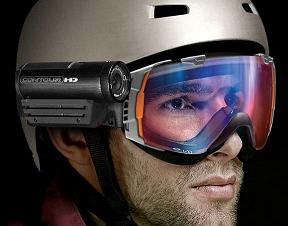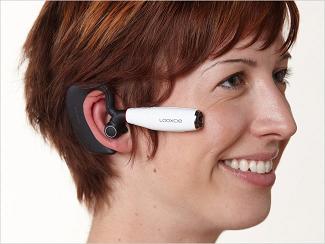Will Life-Logging Be Led by Xtreme Sports and Thrill Seekers? (video)

Share
We all have events in our lives that we wish we could remember better. A photographic memory would sure come in handy. Luckily, technology could provide us with one. An increasing number of people are continuously recording everything they see using wearable cameras. This life-logging allows us to review our lives with picture perfect quality, and to share those experiences via social networks or broadcast them to the internet at large (life-casting). While popular in certain crowds, mainstream culture has yet to embrace life-logging. Who will be the breakout user that pushes the wearable camera concept into a global craze? Probably a surfer. Helmet cameras and mountable video recorders have long been a staple of extreme sports enthusiasts. Much of the highest quality and most reliable equipment is geared towards these users. But it goes deeper than that. What events in your life would you want to remember? Those are the kinds of things that many of these thrill seekers experience as often as possible. That's the kind of excitement that could bring life-logging to the masses. Don't believe me? Let me take you through my argument using the video clips below. One day, life-logging will be for everyone, but its appeal will spring from the craziest among us first.
There's no doubt that life-logging has its origins in nerds and technology wizards. Steven Mann, sometimes referred to as the world's first cyborg, started recording his life 24/7 back in the 80s. He's still at it today. The man is a tech-enthusiast of the first order. So too is Justin Kan, the entrepreneur behind Justin.tv. He was among the first to popularize life-casting on the web. Streaming video of his life was available for years and it served as the foundation for his growing internet media empire. But Aaron, I hear you say, these pioneers weren't extreme sports types at all. Adventure, heh. Excitement, heh. A true life-logger craves not these things.
Here's Steve Mann explaining his EyeTap project:
Ok. While there's a certain fascination that can be had when watching the lives of Mann or Kan, the tens of thousands of hours of their videos are mainly...well, boring. This is their life after all, not yours. Voyeuristic excitement aside, not everything that life loggers will do will be enjoyable to others. Watching the video of Mann above, I'm really intrigued by what I'm seeing, but I'm not encouraged to go out and get a camera of my own and wear it everywhere.
Compare that, with the following:
That was a clip of a 'bike jam' filmed as a promotion for GoPro's wearable cameras. Fun, exciting, a record of an event that you'd likely want to review a few times over, especially if you were a part of it, but even if you weren't. That video is sort of proselytizing. It's supposed to be, of course, it's a commercial. Still, the video draws its audience in with excitement. This isn't any dull moment in the recorded person's life, it's an extraordinary moment.
Here's another such video, this one used to promote Contour's mountable cameras. Here, the 'life-logging' style of recording puts you smack dab in the middle of an intense activity in the rider's life.
We are trained to love extraordinary moments. Plays, TV, movies - these all chronicle interesting stories in a character's history. News broadcasts use narratives to highlight extraordinary moments in the world around us. Even "Reality TV" is just an edited version of real events - a highlight reel of the most entertaining moments in some contrived scenario.
I think that thrill seeking adventurers will pull people into life logging by giving us the extraordinary moments first. It's only after seeing that a character is interesting that we then can become enthralled with every little activity they undertake. Think again, of reality TV starts. First you watch a show because it promises to be fun, enlightening, or controversial. Only later do you start to care about the minutiae of these people's lives. You are pulled in by the fighting, the sky diving, the promises of true love. Once you are emotionally invested only then do you start to care about what people do when they brush their teeth or take out the garbage.
I've shown you action-based videos so far, ones that highlight extreme sports, but even those devices aimed at more mundane life-logging sell themselves by focusing on extraordinary moments. We're not told that we'll record every boring second of our lives, we're sold on the fact that we'll be able to record the really important events. The Looxcie camera is a life logging device that is more suited to the mini-van than the stunt bike. Yet, take a look at the following promotional video:
There can be little doubt that this is a precious time in the user's life. Looxcie is selling its camera using such moments. Their camera runs continuously, but doesn't necessarily record continuously. Instead, the ear mounted device has a special button that you can press when something important happens. The camera then jumps back 30 seconds in its video buffer and records from there. The message is clear: "Looxcie will keep you from missing the important things."
Be Part of the Future
Sign up to receive top stories about groundbreaking technologies and visionary thinkers from SingularityHub.


So, who better to draw attention to life-logging than the people who are striving to make every second of their lives as important as possible? With the advent of cheap, sturdy cameras, these thrill seekers can do more than simply live their exciting adventurers - they can share them. Countour, GoPro, and others like Tachyon and Drift have mountable cameras that work under extreme conditions, make uploading content to the internet easy, and cost less than $200. Pay $100 more and you can get HD quality video and/or GPS tagging. Pay another $100 more and you can get 3D recordings (GoPro and Tachyon) so your adventures can appear in the same cutting edge format that professional sports is moving towards.
Here are HD examples from Drift and Countour:
Here's how I see life-logging coming to the masses. Cheap mounted cameras will allow a growing number of adventure types to record cool parts of their lives and share them. Among such enthusiasts, recording the adventure will become increasingly normal, until it becomes second nature. The prestige that comes from sharing these events may even be as important as performing the activity itself. Who cares if you performed a 720 inverted spin if no one saw it happen? We'll have an edgy, hip part of the populous that encourage themselves to wear cameras all the time in order to record their edgy, hip lives.
From there, the notion of wearing the device will become less alien to the general public. And I think it's wearing the device that is the real hurdle here. We already carry around cameras (and smart phones) with us and decide to pull them out when something exciting happens. The innovation is wearing that camera all the time and never shutting it off.
Free-wheeling excitement is likely to make wearable cameras more appealing, but it's the after effects of this social attitude change that really thrill me. A life-logging camera, once worn continuously, becomes a constant window into your life. Prevailing interests in social networks mean that we're likely to call others to peak into that window as often as they like. Ucorder, whose lightweight camera costs less than $100, is already envisioning this period of time in their advertisements.
Once we start relying upon life-logging cameras to share events with our friends, we may start to rely upon them in even more profound ways. After all, what is a life-log but an external memory of our lives? Microsoft Research in Cambridge has been using their SenseCam with patients whose recollections are failing. Where Alzheimer's strips you of the recent past, Sensecam can fill in the gaps:
When used to its fullest, life logging is more than a tool to share fun moments with the world, it's a cybernetic memory. One that never fades. A memory that you can show to others and that they will accept as objective truth. Why wish to be one of the rare people with a photographic memory when you can just use a camera and computer instead? Dirt bikes and snowboarding will make life-casting sexy. It's those sorts of extreme events, not the constant grind of current life-loggers, that could give wearable cameras mainstream appeal. Once these devices are accepted, however, we will have access to every part of our lives, breathtaking as well as boring. It's a bizarre bait-and-switch. We'll be sold on recording the memorable parts of our lives, but we'll end up using the recording of our lives as our memory.
[image credit: Contour, Looxcie]
[video credits: DaftCyborg, Contour, GoPro, Drift, Ucorder, Microsoft Research]
[sources: GoPro, Looxcie, Contour, Tachyon, Drift, Microsoft Research]
Related Articles

This Light-Powered AI Chip Is 100x Faster Than a Top Nvidia GPU

How Scientists Are Growing Computers From Human Brain Cells—and Why They Want to Keep Doing It

These Brain Implants Are Smaller Than Cells and Can Be Injected Into Veins
What we’re reading

